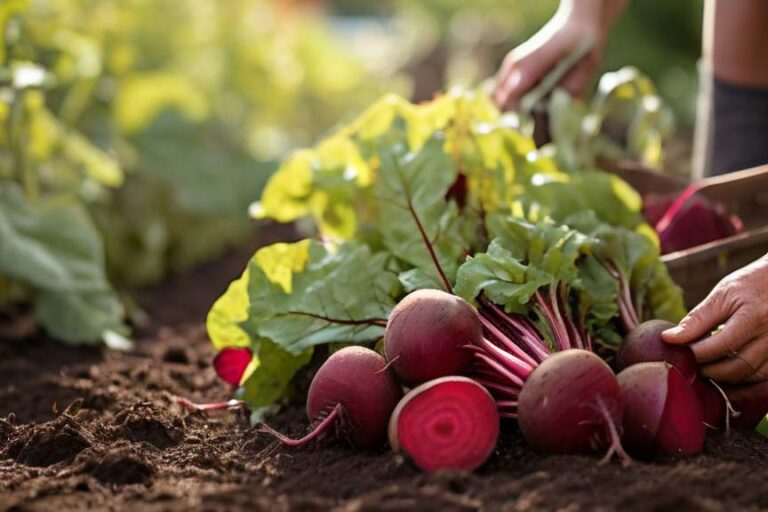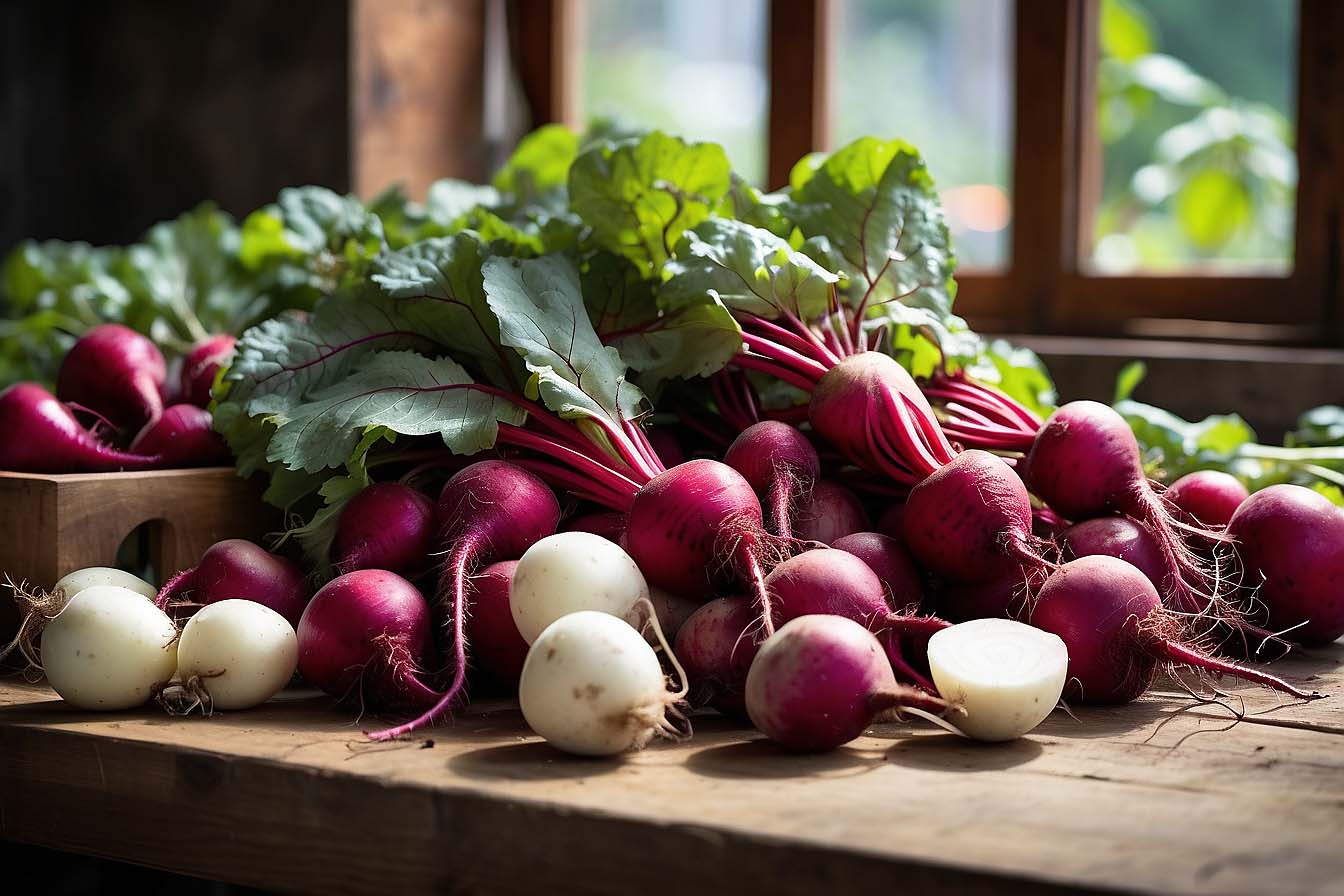Beets and turnips are both root vegetables, yet they differ in taste and nutritional content. Beets are sweeter, while turnips are more peppery.
Beets and turnips grace our tables with distinct flavors and hearty nutrients, each telling a different story from beneath the soil. As root vegetables, they anchor many a dish with their robust profiles—beets delivering an earthy sweetness and deep red vibrancy, and turnips providing a sharp, almost bitter taste with a creamy white hue.
Root Rivals: Beets and Turnips

Welcome to the dynamic duel of the vegetable world—Beets vs. Turnips. These root vegetables may look similar at first glance, but they’re quite distinct. Each brings its own set of flavors, textures, and nutritional profiles to the table. Whether roasted, boiled, or served raw in salads, beets and turnips offer versatility and health benefits in every bite. Let’s dig deeper into the profiles of these underground treasures.
Profile of a Beet

Beets, with their deep red hue and sweet earthy notes, are a unique culinary treat. They are packed with nutrients and come in different colors like yellow and striped. Here’s what sets beets apart:
- Rich in Vitamins and Minerals: vitamin C, fiber, and essential minerals like potassium and manganese
- Variety of Uses: eat raw in salads, roast for a caramelized flavor, or pickle for tangy snacks
- Natural Sweetness: higher sugar content than many vegetables which makes them delightful in dishes
Turning to Turnips
Turnips offer a milder taste profile with a touch of pepperiness. Their white and purple-tinged skin encases a crunchy texture. Turnips are not as sweet as beets but are equally versatile:
| Nutrient Profile | Uses |
|---|---|
| Low in CaloriesGood fiber SourceContains vitamins B6, C, and E | Can be mashed like potatoesRoasted for earthinessStir-fried for a crunchy texture |
Both beets and turnips shine in their own right. Each has a distinct flavor that appeals to different palates. These root rivals can elevate a meal with their unique tastes and textures.
Nutritional Showdown
Welcome to the ultimate nutritional battle between two root vegetable powerhouses: beets and turnips. These earthy gems grace dinner plates worldwide. Yet, many still wonder which one wins the nutrition war. Let’s dive into this epic showdown and compare their health benefits.
Beets and turnips pack a punch of vitamins and minerals in every bite. Which one takes the lead? Here’s a face-off that’ll detail just that:
| Nutrient | Beets | Turnips |
|---|---|---|
| Vitamin C | Good Source | Higher Content |
| Folate | Rich in Folate | Lesser Amount |
| Potassium | Ample Potassium | Comes Close |
| Calcium | Some Calcium | Better for Bones |
For vitamin C, turnips edge out beets, strengthening your immune system. Beets, however, are a folate powerhouse, crucial for cell growth and function. Both roots are high in potassium, which maintains healthy nerve and muscle function. Calcium is more prominent in turnips, making them a go-to for bone health.
Let’s look at the numbers:
- Beets: Lower in calories and carbohydrates.
- Turnips: Even fewer calories, but similar carbs.
When considering calorie and carbohydrate intake, both vegetables are low-calorie choices, with beets slightly higher in carbs but also providing essential natural sugars for energy. Turnips, on the other hand, are a bit lighter on the scale, making them a favorite for weight-conscious diets.
This showdown reveals both beets and turnips as champions of nutrition. Their unique profiles offer various health benefits, making them both excellent dietary choices. Beets and turnips thrive in nutrients, flavor, and versatility. Include them in your meals to enjoy their unique benefits.
Learn more: Pros and Cons of Growing Turnips
Culinary Uses and Flavors
Both beets and turnips grace kitchens with their unique flavors and culinary versatility. These root vegetables offer distinct tastes and benefits that liven up a range of dishes. Let’s explore how beets and turnips stand out in cooking.
Beets in the Kitchen
Beets burst with deep, earthy flavors. Their sweetness shines through when roasted, boiled, or steamed. These vibrant roots don’t just taste good; they look good too. Their rich red hue can turn any dish into a visual masterpiece.
- Salad Star: Sliced or grated, beets add crunch and color to salads.
- Smoothie Booster: Blend into smoothies for a nutrient-packed snack.
- Pickling Perfection: Pickling beets preserves their taste and extends shelf life.
Beet greens are also edible. Sauté them like spinach for a nutritious side dish.
Cooking With Turnips
Turnips offer a peppery bite, which softens into a gentle, sweet flavor when cooked. These roots are not as sweet as beets, but their versatility is remarkable. Whether in stews or as crispy fries, turnips delight the palate.
| Cooking Method | Effect on Flavor |
|---|---|
| Mashed | Turnips become creamy and subtly sweet. |
| Roasted | Edges caramelize, taste intensifies. |
| Raw | Crunchy and sharp, ideal for salads. |
Turnip greens, like beet greens, also hold valuable nutrition. They add a peppery layer to dishes when cooked or used fresh in salads.
Growing in the Garden
Dig into the magic of gardening as we unearth the secrets to growing beets and turnips! These radiant root vegetables bring a bounty of benefits to your table, and yielding a successful harvest starts right in your backyard. Today, we spotlight these subterranean superstars and reveal how you can cultivate them to perfection.
Cultivating Beets
Beets, with their deep red hue, are as nutritious as they are vibrant. A cool-season crop, beets thrive in well-drained soil with a pH between 6.0 and 7.0. Packed with minerals and vitamins, they are easy to grow with these pointers.
- Time to Plant: Sow beet seeds in early spring or late summer.
- Soil Prep: Loosen the soil to a depth of 12 inches.
- Spacing: Plant seeds 1 inch apart in rows 12 to 18 inches apart.
- Watering: Keep soil evenly moist without over-watering.
Turnip Gardening Tips
Turnips are a versatile bunch, as eager to grow as they are to be eaten. They prefer cooler weather and can be grown in both spring and fall.
| Task | Turnip Tip |
|---|---|
| Planting Season | Sow 2-3 weeks before the last frost for Spring, and mid-Summer for Fall. |
| Soil Conditions | Work the soil well and ensure it is free of rocks for smooth turnip growth. |
| Seed Depth | Plant seeds 1/2 inch deep. |
| Harvest Time | Pick when they’re small and tender for the best flavor. |
Health Impacts and Benefits
Exploring the vibrant worlds of beets and turnips reveals a treasure trove of health benefits. These root vegetables pack powerful nutrients into every bite, making them essential staples for a healthy diet. Not only do they offer a plethora of vitamins and minerals, but they also contribute to overall wellness with their unique properties.
Beet Benefits for Wellness
Beets shine in vibrant reds and purples, boasting a superb profile of health-boosting effects:
- Rich in Antioxidants: Beets contain betalains, pigments with potent anti-inflammatory properties.
- Heart Health: The high nitrate content helps lower blood pressure and improve cardiovascular function.
- Stamina Enhancement: Converts nitrates to nitric oxide, which can enhance exercise performance.
- Detoxification Support: Aids in flushing toxins from the body, promoting liver health.
Turnip Contributions to Health
Turnips, with their crisp bite and mild flavor, deliver a host of benefits:
- Digestive Aid: High fiber content supports a healthy digestive system.
- Bone Strength: Offers calcium critical for maintaining strong bones.
- Weight Management: Low in calories yet high in fiber, making them ideal for satiety.
- Immune Booster: Packed with vitamin C to fortify the immune system.
| Nutrient | Beets | Turnips |
|---|---|---|
| Fiber | High | High |
| Vitamins | B9, C | B3, C |
| Minerals | Potassium, Iron | Calcium, Potassium |
Conclusion
In the duel of beets versus turnips, your choice boils down to personal preference and nutritional priorities. Each root vegetable brings its own vibrant colors, distinct flavors, and health benefits to the table. Whether you’re after beet’s hearty antioxidants or turnip’s digestive aids, both offer versatility in the kitchen.
Embrace the one that suits your palate and enriches your meals. See all in at Farm Pioneer for knowledge based for Turnips.
